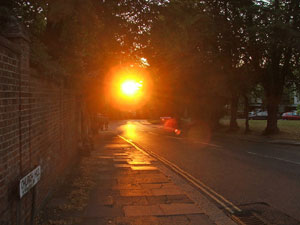 New York – Turning toward the glare of the setting sun doesn’t qualify as a traffic emergency that excuses ordinary negligence, according to New York’s top court.
New York – Turning toward the glare of the setting sun doesn’t qualify as a traffic emergency that excuses ordinary negligence, according to New York’s top court.
Subscribe to our Daily Roundup Email
The Court of Appeals rejected Derek Klink’s claim he faced “a sudden and unexpected circumstance” from temporary blindness when his car fatally struck pedestrian Irene Lifson in February 2000.
The court, divided 5-2, is sending Klink’s case back to the trial court, where a jury initially concluded the city of Syracuse was 15 percent negligent and Lifson was 85 percent at fault.
Jurors had been instructed to consider the emergency doctrine, where they should first determine whether the driver faced an emergency situation and responded prudently. The doctrine recognizes that drivers in emergencies “cannot reasonably be held to the same accuracy of judgment or conduct as one who has a full opportunity to reflect.”
Chief Judge Jonathan Lippman wrote that Klink was turning west after leaving work shortly after 4 p.m. on Feb. 29, the time of day the sun would be setting. “It is well known, and therefore cannot be considered a sudden and unexpected circumstance, that the sun can interfere with one’s vision as it nears the horizon at sunset, particularly when one is heading west,” he wrote in the majority opinion.
“This is not to say that sun glare can never generate an emergency situation but, under the circumstances presented, there is no reasonable view of the evidence under which sun glare constitutes a qualifying emergency,” Lippman wrote. He noted there was no evidence that Lifson, who was wearing a red coat, darted in front of the car or that Klink was speeding.
Judges Carmen Beauchamp Ciparick, Victoria Graffeo, Eugene Pigott Jr. and Theodore Jones Jr. agreed with Lippman.
“I admit that sunset is a foreseeable event. Yet surely everyone who has driven a car knows that good drivers are sometimes surprised to find the sun in their eyes,” Judge Robert Smith wrote in the dissent, joined by Judge Susan Read. “In deciding whether an emergency instruction was properly given, the issue is not whether the emergency was foreseeable; it is whether it was sudden and unexpected.”
Smith noted a previous ruling by the top court that a child darting in front of a car passing a park where children played was foreseeable, but nonetheless sudden and unexpected, and therefore constituted an emergency situation.
In another case, a divided court ruled that a driver out in snow, frozen rain and hail did not face an unexpected emergency when her car hit a sheet of ice, that anyone driving with reasonable care in those conditions shouldn’t have been surprised. Smith concluded that Klink’s case was different, driving on a Syracuse street where buildings do and sometimes do not block the sun on a route he was unfamiliar with.
Attorney Donald DiBenedetto, representing Klink, said while the jury won’t be told to consider the emergency doctrine when the case returns to trial court, his proof will probably remain the same, that his client was blinded by the sun’s glare. “The explanation for why the accident happened won’t change,” he said.
Calls to the lawyer for Lifson’s family were not immediately returned.

What a dumb excuse. There is something called a visor and it was made for a very good reason.
I’m trying to figure out why Syracuse is “15 percent negligent.”
Did Syracuse make the sun a bit too bright?
Further, Number One Commenter, above, the sun is sometimes at a low enough angle that a visor will not help.